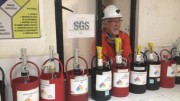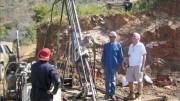The mine that Thompson Creek Metals (TCM-T, TC-N) is building in central B.C. will be a novel operation in many ways.
For one, it will be the province’s first major new metal mine in 15 years.
The 40-foot, semi-autogenous grinding (SAG) mill will be the largest of its kind on the continent, and the primary crusher is the tallest in Canada.
All of the concrete under the mill and other buildings — the impermeable clay in the tailings storage facility dam, the fill used to build the 110-foot wall that towers above the primary crusher and the rest of the bulk materials used to transform the property into a mine — came from a pervasive layer of glacial till on-site that provided every kind of clay, rock and sand needed.
Because of this synergy, the mine does not need a waste dump. Moreover, the entire mine is contained within an area measuring just 3 by 4 km, which is a small footprint for an open-pit mine with a 22-year life expectancy.
And if the next year goes according to plan, Thompson Creek will finish building this $1.5-billion mine without a cent of conventional debt — which is perhaps the most novel aspect of all.
Mount Milligan is a busy place these days. There were 1,112 people on-site when The Northern Miner visited, and that is down from the busiest times during the 30-month build.
The project is more than 70% complete. The massive SAG mill is installed, along with two ball mills, all the lines of rougher and cleaner flotation cells and the concentrate load-out bay. With the large items in place, workers can seal off the building from the cold winter air. It’s a long-sought goal, after spending last winter completing 36-hour concrete pours and installing a huge, outdoor steel structure in northern B.C. winter conditions.
Work is also continuing outside. In December the company commissioned the second of its massive shovels, both of which are now stripping overburden from the first pit area. A designated fleet of haul trucks take the overburden across the property to the tailings storage facility, where earth-moving machines pile it atop the growing tailings dam.
Meanwhile offices are being wired, machine shops are being outfitted, water pipes and fibre optic cables are being run to every corner of the site, new employees are being trained and a thousand other tasks are being completed in preparation for the targeted start-up in a few months.
At first glance, Mount Milligan is a straightforward operation, an open-pit mine tapping into a near-surface porphyry deposit with metals that respond well to conventional grinding and flotation processes to produce marketable concentrates.
But no new, large mine is ever simple, not even one located fairly close to roads, power and people. In addition, well-designed new mines incorporate a slew of great features, from rolling bales that keep each shovel’s power cable off the ground to a site-specific cell tower, keeping the mine connected to the outside world.
“There are just so many ancillary things involved to get this mine up and running,” Mount Milligan construction manager Bert Jeffries comments. “It feels like I’m the mayor of a village.”
That village is being built to tap into a near-surface copper-gold resource that has been perforated with almost 1,000 drill holes over the last 20 years. The resource is divided into four zones, but all four are connected and fit nicely into two pit shells, known as the North and South pits.
Shallow ore
Mining will start in the North pit because the ore is closer to surface — in some spots, there is just 5 metres of overburden. In fact, easy access to ore is one of Mount Milligan’s virtues. Over the 22-year mine life, the operation’s strip ratio will average just 0.84 to 1 waste to ore.
The deposit at Mount Milligan is a classic porphyry, complete with higher gold grades near-surface that will boost the project’s economics in its early years. The project’s proven and probable reserves total 482.4 million tonnes at an average grade of 0.2% copper and 0.388 gram gold per tonne, for 2.1 billion contained lb. copper and 6 million contained oz. gold.
In addition, the project is home to 224 million measured and indicated tonnes grading 0.15% copper and 0.21 gram gold that are not included in the reserve count.
Two massive electric shovels will pull 100,000 tonnes of rock from the pits each day, including 60,000 tonnes of ore. ‘Shovel’ does not seem a big enough word to describe these machines, which tower more than 100 feet above the ground. With just two and a half bucket loads, one of these shovels can fill a 240-tonne haul truck. And they are electric, each one dragging a power cable fitted with bales that make the cable easier to see and move.
A fleet of 793 Caterpillar haul trucks will receive ore from these shovels and ferry it to the top of a 110-foot, mechanically stabilized earth wall, from where they can dump their loads into the 100-foot-tall primary crusher. There are nine haul trucks on site. As the pit deepens the haul road will get longer — meaning longer trip times. Within two years, Thompson Creek expects to have 12 haul trucks in operation.
A trip through the primary crusher will break the rocks into pieces no larger than 6 inches, which will gather in a stockpile. A conveyor will then take ore from the stockpile into the 40-foot SAG mill, a goliath piece of machinery. Installing the mill was a major challenge. For example, five huge pieces of machined steel hold the mill in place. Each one weighs more tha n 100 tonnes and the bolts that attach them to the surrounding structure are the size of a big cucumber, yet the tolerances for installing these bolts measure in the microns.
After a few minutes in the SAG mill the ore moves on to one of two ball mills, which reduce 80% of the rocks to less than 75 microns. This is the optimal grind size for operation, where the costs of further grinding negate the benefits of higher recoveries from smaller particles.
Once the ore is ground, it’s time to extract the metals. The process facility uses conventional flotation techniques, sending the ground ore slurries through multiple sets of rougher and cleaner flotation tanks, as well as regrind circuits.
“We’re putting $1.5 billion into this facility to get one fifteen-minute shot at it,” Mount Milligan plant manager Patrick Gannon says, describing the rougher and cleaner flotation process. “In those fifteen minutes, you’re either going to get the metal out of the rock or you aren’t.”
Provided it all works, each day the mill will transform 60,000 tonnes of ore into 400 tonnes of concentrate grading 26% copper and 30 grams gold, which translates into average life-of-mine annual production of 81 million lb. copper and 194,000 oz. gold. At first, output will be higher, as the mine processes the gold-enriched upper zones of the deposit, resulting in annual output averaging 262,000 oz. gold for the first six years.
The concentrate will be loaded onto trucks, but the company hasn’t decided where those trucks will go. At first the company planned to truck its product to Fort St. James, where it would be loaded onto railcars for transport west to Prince Rupert. When this plan was established the rail load-out facility in Mackenzie was unavailable, as it was being used to capacity.
Now that has changed, which means Thompson Creek might truck its concentrates to Mackenzie instead. The advantage in sending concentrate north is that the road to Mackenzie is a private one, which avoids the additional concerns that arise when large trucks have to share the road with public users. However the company is not yet sure which route will be chosen.
This describes the flow sheet for the metals, but the gangue goes elsewhere &mdas
h; to the tailings storage facility (TSF). Defined by a dam that contains this fluid mill waste, the TSF will grow deeper as the mine ages because Thompson Creek will continually pile waste rock on top of the dam’s impermeable clay core. Twenty-two years from now, when Mount Milligan is winding down, the deepest parts of the TSF will hold 85 feet of tailings.
More than a mill
“Logistics are one of the biggest challenges in building a mine of this size,” Jeffries says. “All of this construction material — you have to bring it in on big trucks, unload it, deck it and label it, and find it when you need it and transport it to where it’s being installed. The logistics side is just fascinating.”
He has a point. It’s easy to focus on the mill building and the pit equipment, but a mine like Mount Milligan requires extensive supporting infrastructure. For example, the truck shop is massive, with a wash bay that alone is the size of a small factory.
Another good example is the fleet of earth-moving machines dedicated to building the TSF. This fleet is separate from the shovels and haul trucks that move ore, and this second set of machines will also operate for the entire life of the mine, continually adding waste rock to the TSF dam.
Then there’s the need for power: Thompson Creek had to build a 92 km power line along the road from Mackenzie as well as a substation on-site to step the voltage down from 230 kV to 25 kV. From there, a network of lines disperses power throughout the mine site.
The list of ancillary tasks involved in building Mount Milligan continues. Trees had to be cut, sorted and either sold or stored for use in reclamation. Innumerable pumps buried all over the site move water this way and that: through buildings, around the mill, from seepage ponds back into the TSF and from the TSF to the water-recycling facility and back into the mill.
A nursery is being built to grow native plants in preparation for reclamation work. A slew of offices need to be wired and furnished. Classrooms are used to train groups of new workers. Snow has to be cleared constantly from roads and parking lots. Cooks are at work, trying to feed the hundreds of workers passing through the cafeteria every day.
And if the company gets approval, soon another task will be added to the list: building a 450-room residence on-site.
Mount Milligan is located 100 km northwest of Prince George in central B.C. There are two routes into the site: a 90 km road north from Fort St. James, or a 92 km road south from Mackenzie.
“Proximity to not just one community but two is a real benefit,” Thompson Creek director of corporate responsibility Jocelyn Fraser says, as she drives to the mine from Fort St. James. “People coming to work here can move with their families, which gives the communities a big boost — it’s great for everyone.”
Initially, the Mount Milligan development team planned to house the mine’s workforce in one of the communities, but it has since become clear that the commute is too long for some. In winter it can easily take an hour and a half to drive each way, which means adding some three hours of transit to workers’ 12-hour shifts.
As such, the company has applied for permission to build a 450-room residence on site. The building will be bigger than necessary — at full capacity, Mount Milligan will require 350 workers and 50 support staff, with 200 expected to live on-site. The extra capacity will be available for contractors or guests.
Paid in full
Thompson Creek is three-quarters of the way through building a $1.5-billion mine, and yet in November the company cancelled its revolving-credit facility because it had no need for it. Indeed, Mount Milligan’s most novel characteristic may be that it was paid for in cash.
A fair chunk of the funding for Mount Milligan came from Thompson Creek’s other mines, though in recent months those operations have struggled. The problem at both mines is low molybdenum prices. After spiking to US$45 per lb. in 2007 from less than US$5 per lb. in 2002, the price of molybdenum oxide has fallen back to US$12 per lb. Both of Thompson Creek’s other mines — the Endako mine in northwest B.C. and the Thompson Creek mine in Idaho — produce moly, so the low price has created headaches.
The company suspended mining at Endako in August, saying that low moly prices were exacerbating problems from operational issues and lower-than-expected ore grades. Mining will not resume at the operation until “moly prices improve.” The company continues to process stockpiled ore at the site.
Less than two months later Thompson Creek suspended stripping activity associated with the next phase of production at its Thompson Creek mine. Mining operations there will continue as planned through 2014, but if moly prices have not improved enough by 2015 to justify the prep work required for the next phase, “the company expects that the mine would be placed on care and maintenance at such time.”
With operations at two mines partially or wholly suspended because of one metal price, it’s no surprise Thompson Creek is excited to get another mine into operation — especially one unrelated to the price of moly. In fact, the feasibility study and reserve estimate for Mount Milligan used a copper price of US$1.60 per lb. and a gold price of US$690 per oz., which means the mine should be economic at prices some 40% below current spot rates.
But that only matters once the mine is up and running, so Thompson Creek had to ensure it had enough money to finish building Mount Milligan, even without much cash flow from its moly mines. To fill any potential funding gaps, Thompson Creek raised $350 million near the end of 2012 by selling high-yield debt on the bond market. The company offered senior secured first-priority notes that carry a yield of 9.75%. This is the only debt that Thompson Creek will carry once Mount Milligan is complete.
The company also pulled in cash through a series of deals with gold-streaming company Royal Gold (RGL-T, RGLD-Q). Most recently Royal Gold handed over $200 million for the right to buy an additional 12.25% of Mount Milligan’s gold at US$435 per oz. (or the prevailing market price, if lower). The streaming company previously bought the right to buy 40% of the mine’s gold production in two separate deals, which means Royal Gold is set to purchase 52.25% of Mount Milligan’s gold. For this right, the streaming company has invested a total of $781.5 million.
With the additional Royal Gold monies and funds from the bond issuance, Thompson Creek is in fine shape. The company has already spent almost $1 billion at Mount Milligan, leaving $500 million to go.
The company plans to commission the mine in this year’s third quarter, with the goal of reaching commercial production before year-end.






Be the first to comment on "Countdown to production at Mount Milligan"